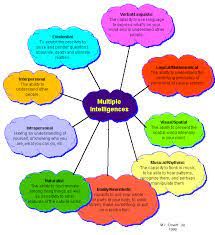The
application of multiple intelligence theory is wider as a framework of research
in teaching and learning. It has various implications for teachers to address
the needs of their students in classrooms. Nasab & Ghafournia (2016) found
that all eight intelligence have their own needs in society for productive
functions of different elements. Therefore, multiple intelligence has paramount importance in education.
First and foremost, applying multiple
intelligence ensures to change traditional education systems which emphasize
only two intelligence namely verbal and mathematical. The students with
intelligence other than verbal and mathematical intelligence show a lack of
motivation in carrying out learning tasks. Multiple intelligence takes into
account a wider range of talents to be explored and developed. Therefore, teachers need to select and
organize learning activities and tasks which cater to the needs of the students
with intelligence in other areas as well as linguistics and mathematics.
Learning
activities and tasks incorporating multiple intelligence not only excite
students to take part in activities but also reinforce learning through the
same material in a variety of ways. By applying a variety of learning
activities embedded with multiple intelligence, teaching can facilitate students
to be engaged deeply in understanding the subject matter. The students enter
into the classroom with different sets of learning needs on the basis of their
dominating intelligence. The students in a classroom have their own sets of
mental strengths and weaknesses. These sets determine the level of easiness or
difficulty for them to from the presented material in a particular manner.
The content
or subject matter prescribed has the potential to get students more involved if
multiple intelligence is addressed because that will be more appealing and
motivating. Since motivation is a key factor in learning, therefore, students
in the classroom may be facilitated while making learning activities highly
practical through tabooing students’ intelligence and gearing their motivation
to their needs. One student may enhance his/her level of motivation up by
watching a movie in a classroom while another may be motivated to play a role in
any conversation. This technique suits the schools where one teacher teaches a
class the same subject throughout the year. The teaching based on multiple
Intelligence maximizes learners' academic achievements and enhances their
performance. It implies that teachers, planners, and materials developers need
to take this level of personal differences into account in their professional
practices.
Murray &
Moorey, (2012) are of the view that applying multiple
intelligence in the classroom provides choices for the students which enable them
to identify their personal qualities, learning style. Resultantly, they feel
that they are valued for their personal achievement. In order to cater to the
needs of students with a range of multiple intelligence in diverse classrooms,
teachers need to differentiate the teaching-learning process to create an
inclusive learning environment. Classrooms with differentiated learning and
inclusiveness help teachers to more effectively meet the needs of all students.
The application of Gardner’s multiple intelligence theory promotes an inclusive
environment by valuing that all individuals have strengths in different areas.
While
engaging in learning activities based on multiple intelligence, students
identify the tasks which motivate and allowing them access to explore their
strengths and abilities. The eight intelligence identified by Gardner can be
used individually or in conjunction with one another to enable students to
identify their preferred style of learning. Utilizing strategies that
accommodate students’ multiple intelligence in the classroom enables the
teacher to create an inclusive classroom environment in relation to multiple
intelligence. This ensures that teaching in a variety of ways to cater to
individual differences and ensures education is accessible for all.

